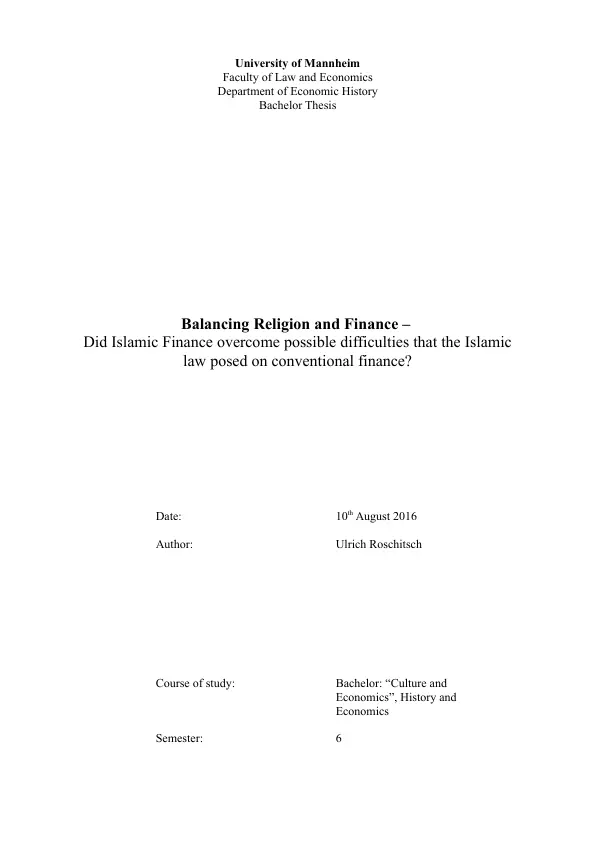Since the mid-1970s, an industry growing at considerable pace in the Islamic world is gaining market shares all over the world in countries with sufficient Muslim populations. This “Islamic Finance” industry claims to act in line with the ethical and practical principles set forth in the Qu'ran and the Shari'ah, thus appealing to Muslim and non-Muslim clients alike who search for viable alternatives to conventional financial products. As explained, the first beginnings of this phenomenon can be traced well back into the 1970s when the first “Islamic Banks” started operating in Egypt and Jordan.
In the past decades, a vast amount of research has been published – empirical and theoretical – to review the impacts of Islamic Finance on the financial markets of the Islamic world. These works, to a great deal inspired by the enormous need of the industry for quantitative and qualitative research, all dealt with questions of comparative efficiency of conventional and Islamic Finance, the demand for Shari'ah-compliant financial products, the actual genuineness, or authenticity, of the industry, etc. However, only a very small portion of these research works dealt with the question whether or not the Islamic world actually needs Islamic Finance.
At first, this might seem as a trivial question (if there was no need for Islamic Finance, there would not have been this substantial growth). But at second thought, one realizes the associations that come which come with the question of raison d'être: Why did Islamic Finance emerge? Does it add an economic value to its markets? And most importantly, is it – so far – successfully reaching its goals? To my understanding, the works that deal with this big-picture analysis, are thin on the ground. Therefore, this work shall take a first step at putting Islamic Finance into the historical context it needs to be seen in, by compiling the manifold works into a cross-sectional approach to characterize the industry. The most salient aspects of the analysis here will be legal, historical, and economic ones, in order to grasp the 'big picture' of Islamic Finance.
Inhaltsverzeichnis (Table of Contents)
- Introduction
- What were the exact investment problems of conventional finance?
- Financial operators before Islamic Finance (supply side)
- The Islamic financial markets between 1850 and 1970 (roughly): structure and size
- The role of the Shari'ah: prescription and reality in conventional finance
- The consumers' preferences before Islamic Finance (demand side)
- Defining the consumers of conventional finance and their difficulties with conventional finance
- Which financing methods were common?
- Pre-conclusion: What did the restraining impact of the Shari'ah and the consumers' religious mentalities on conventional finance exactly look like?
- Did Islamic Finance provide solutions to the hitherto carved out problems?
- What is Islamic Finance?
- The concept of Shari'ah-compliance
- What is the \"Islamic world\" - or: which countries are important to survey?
- Islamic banking and Investment
- Takaful or Islamic insurance
- The market situation with Islamic Finance
- Is Islamic Finance working on the markets? (supply side)
- How 'big' is Islamic Finance? Structure and size of the markets
- Is Islamic Finance working? The comparative efficiency of conventional and Islamic Finance
- Is Islamic Finance really Shari'ah-compliant? The disputes around Islamic Finance
- Who is interested? The demand for Islamic Finance
- The difficulties that conventional finance encountered in Islamic markets before the 1970s
- The role of Islamic law (Shari'ah) in shaping both the supply and demand sides of the financial market in the Islamic world
- The key features of Islamic banking, Islamic investment, and Islamic insurance
- The structure, size, and efficiency of Islamic financial markets in comparison to conventional markets
- The acceptance and preference for Islamic Finance among both Muslim and non-Muslim consumers
- Introduction: This chapter provides an overview of the rise of Islamic Finance as an alternative to conventional financial products in the Islamic world. It highlights the growth of the industry and the various reasons for its adoption and challenges faced in different countries.
- What were the exact investment problems of conventional finance?: This chapter delves into the specific problems faced by conventional finance in Islamic markets before the emergence of Islamic Finance. It examines the restrictions imposed by Islamic law on the supply side (financial operators) and the demand side (consumers' preferences). This includes a detailed analysis of the role of Shari'ah and the influence of religious mentalities on conventional financing methods.
- Did Islamic Finance provide solutions to the hitherto carved out problems?: This chapter explores the fundamental principles of Islamic Finance, defining its concept of Shari'ah-compliance and analyzing the “Islamic world” in terms of relevant countries. It provides an overview of Islamic banking and investment, as well as Takaful or Islamic insurance. This chapter also examines the market situation of Islamic Finance, including its structure, size, and efficiency. It discusses the debate on the true Shari'ah-compliance of Islamic Finance and analyzes the demand for Islamic Finance products.
Zielsetzung und Themenschwerpunkte (Objectives and Key Themes)
This work examines the emergence and development of Islamic Finance in the context of the challenges that conventional finance faced in the Islamic world. It investigates whether Islamic Finance effectively addressed these challenges by offering a financial inclusion model that adheres to Islamic law (Shari'ah).
Zusammenfassung der Kapitel (Chapter Summaries)
Schlüsselwörter (Keywords)
This work focuses on the relationship between Islamic law (Shari'ah), conventional and Islamic finance, and financial inclusion in the Islamic world. Key themes include the prohibition of interest (riba), the emergence and growth of Islamic financial institutions, the structure and size of Islamic financial markets, the efficiency of Islamic financial instruments, and the demand for Shari'ah-compliant financial products.
- Quote paper
- Ulrich Roschitsch (Author), 2016, Balancing Religion and Finance. Did Islamic Finance overcome possible difficulties that the Islamic law posed on conventional finance?, Munich, GRIN Verlag, https://www.grin.com/document/340096



